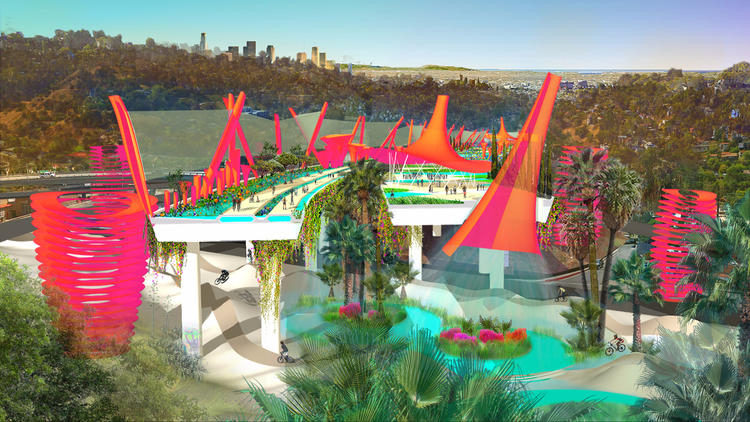Associate professor in practice of landscape architecture Chris Reed and his firm, Stoss Landscape Urbanism, have received praise for a proposal that reimagines a mile-long stretch of Los Angeles freeway as a vibrant, eco-sensitive public space.
The subject of Reed’s proposal is the southwest spur of Southern California’s 2 Freeway, which he reenvisions as not only a pedestrian- and bicycle-friendly public space, but an engine for environmental, economic, and cultural betterment. The proposal suggests this sort of approach could inspire similar reconsideration of freeways and highways throughout the region.
“Residents would benefit in all sorts of ways from this reimagination of the freeway,” writes Los Angeles Times architecture critic Michael Hawthorne, who penned a series of articles last year about revamping Los Angeles freeways including the 2 Freeway stub.
Hawthorne continues, “[Reed’s] proposal for turning that part of the freeway into an elevated park is a sort of fantasia—in shades of orange and fuchsia—on the classic Los Angeles themes of water, sunshine, and the infrastructural sublime.”
Among other elements, Reed’s plan embeds features that would address persistent regional concerns over air quality and the availability of water. Resurfaced laneways and elevated structures along the proposed plan collect rainwater, supplying the site with irrigation for new planted areas in both wet and dry weather. Modest amounts of this stored water are also used for cooling towers stationed throughout the park, which offer a light, cooling mist on particularly hot days. Dew harvesters collect atmospheric water for this misting and for irrigation, while a fog fence gathers water particles from fog and deposits the condensed water in channels below.
Addressing air pollution, smog filters employ ionic filters to capture airborne particles, and repaved laneways absorb carbon from the atmosphere and recharge it in the earth, completing the carbon cycle.
“It is neat to think about how something like a freeway could in fact become a net absorber of smog and carbon dioxide rather than contributing to pollution and climate change,” notes Time Out LA.

Reed’s plan bundles these and other eco-smart strategies within a visually vibrant and socially compelling layout. The mono-functional freeway is reinvented as a pedestrian- and bicycle-friendly recreation park, with shaded gathering space for cafes, community centers, and other cultural activities.
The space beneath the freeway’s overpasses is also opened to the public, rendered as an eco-recreation area. Visually framing the project, the physical structures throughout the park are colored in vibrant, friendly shades of orange and fuchsia.
What happens to the traffic that currently crosses this spur? While bound to stir debate, the concept of rerouting freeway traffic has high-profile precedents, as Hawthorne notes: other cities, including San Francisco and Seoul, “have removed stretches of freeway that once carried far more traffic than the stub end of the 2—and have lived not only to tell the tale but to wonder why they didn’t make the change earlier.” (Reed specifies solutions in the proposal, noting that the modest volumes of traffic currently using the freeway stub could be redirected at the 5 Freeway interchange onto Allesandro Street.)
In addition to drawing Los Angeles into a national dialogue over the future of urban highways, the broader gains from Reed’s proposal, are many, Hawthorne adds. “One great promise of the proposal is what it would mean for economic development in this part of Los Angeles,” he observes. “Pieces of land that have been noisy and polluted would suddenly overlook a quiet green space. There is no doubt they would become immediately more desirable in social, urban, and economic terms.”
Reed has been nationally and internationally recognized for projects in the fields of landscape and urbanism. He was involved in major revisioning strategies for downtown Dallas and its riverfront; for derelict refinery and port sites along the lakefront in Mississauga, Canada; for the city of Detroit; for major new waterfront developments in Shanghai and Green Bay; and for a vibrant new plaza at the heart of Harvard’s campus.
Reed’s work through Stoss has been recognized with the 2012 Cooper-Hewitt National Design Award for Landscape Architecture; the 2010 Topos International Landscape Award; and various other practice- and project-based awards from Progressive Architecture, the American Society of Landscape Architects, the Architectural League of New York, the Waterfront Center, EDRA/Places, and the Boston Society of Architects.
To learn more about Reed’s Los Angeles proposal, please visit Hawthorne’s feature in the Los Angeles Times.
All images courtesy Chris Reed/Stoss Landscape Urbanism
